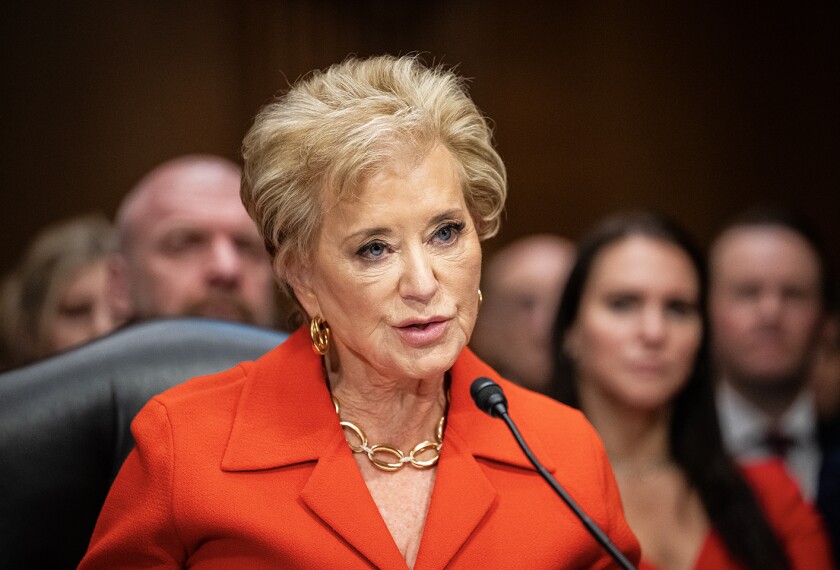Includes updates and/or revisions.
The U.S. Department of Education has released draft guidance to states and school districts on how to apply for waivers that would give them more flexibility in spending economic-stimulus money tied to Title I, the federal program for schools with high numbers of students in poverty.
The guidance also includes proposed waivers that follow up on an earlier promise made by Secretary of Education Arne Duncan to revisit some Title I regulations that were passed last October by the Bush administration.
The American Recovery and Reinvestment Act is providing a $10 billion infusion of Title I money to the states. By allowing waivers, the department is saying that states, districts, and schools don’t have to follow all of the same rules when spending the stimulus Title I money as they would have to when using their regular Title I federal appropriation.
For example, schools that are in “in need of improvement” status based on their test scores under the No Child Left Behind Act must now spend 10 percent of their Title I funds on professional development. The Education Department will allow schools to apply for waivers of that requirement for their stimulus Title I funds.
Also, districts are required to set aside up to 20 percent of their Title I dollars to pay for students in low-performing schools to receive tutoring outside the regular school day, referred to as “supplemental educational services,” or transportation to higher-performing schools if students choose to transfer. Under the guidance released last week by the department, districts can apply for a waiver from that requirement for their stimulus dollars.
Needed Flexibility
“We’re delighted by the waiver guidance,” said Mary Kusler, the assistant director of government relations for the American Association of School Administrators, in Arlington, Va. “It does show some recognition of the flexibility that is needed with these unprecedented funds.”
The association was pleased that Mr. Duncan announced that the guidance was coming during a July 7 phone call with its members, Ms. Kusler said, and that the department was requesting feedback, if quickly. The deadline for responding to the draft guidance, released July 7, was July 13.
The new guidance also offers a way for districts to request waivers from Title I regulations that were released in October 2008. In an April 1 letter to state schools chiefs, Mr. Duncan had said he was planning to review those regulations, with an eye toward repealing or offering waivers for some elements.
As a part of that process, the new guidance offers a way for districts with one or more schools in improvement status under No Child Left Behind to offer supplemental educational services to students in addition to a chance to transfer to a higher performing school. This waiver would apply to Title I schools that are in the first year of school improvement.
Under current regulations, a school that is identified for improvement, corrective action, or restructuring cannot be a provider of extra tutoring. The same disqualification applies to districts identified for improvement or corrective action.
In his April 1 letter, Mr. Duncan said he wants to repeal those restrictions entirely, because they hold districts and schools to different standards than other entities, and limit competition among tutoring providers. But because the process of repealing the provision is expected to take time, Mr. Duncan is starting with waivers of that rule for the 2009-10 school year.
The guidance document also indicates that states may apply for a waiver of the rule requiring that they give parents of children in poorly performing schools at least 14 days’ notice of public school transfer options.
Mr. Duncan said in his April letter that he encourages districts to give far more than 14 days’ notice to parents. But, he added, he has heard from states that cannot change their testing schedules or contracts with test vendors to get the results quickly enough so that parents can receive 14 days of notice for the upcoming school year.
Jeff Simering, the director of legislative services for the Council of the Great City Schools, in Washington,said the guidance will be critical for districts. However, he said, the relatively late release of the document means that some districts and states have had to create plans for spending Title I money without taking into account waivers that they knew were coming.
“The program years begin July 1, and we’ve had to submit our stimulus applications before we had forms and guidance,” he said. Some states and districts will now have to resubmit plans, he said.
Ms. Kusler noted that concern, but said she recognized that the department had to wait for the White House and the Office of Management and Budget to weigh in before releasing the guidance. “We recognize that this is a long time in the making,” she said.







